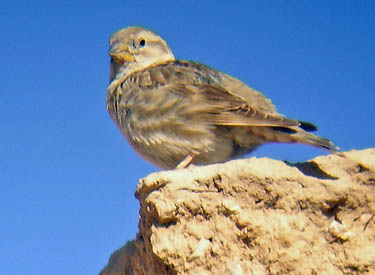
a web page by Don Roberson |
OLD WORLD SPARROWS Passeridae |
||
|
||
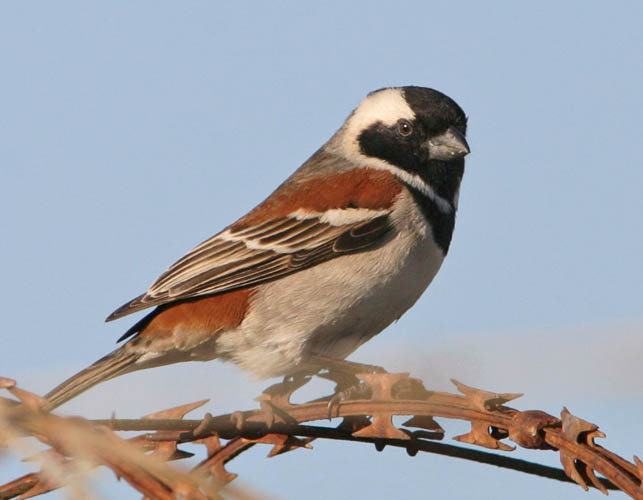 The
Old World Sparrows [Passeridae] are familiar to most people, even those
who are non-birders, because some of them are ubiquitous urban
sparrows. Two species [House Sparrow, Eurasian Tree Sparrow] have been
introduced to non-native urban habitats almost worldwide. I also think
of them as birds of cold and blustery high elevations across Eurasia
(i.e., snowfinches). Yet there are just as many species in Africa as
anywhere else, and this sometimes comes as a surprise. This one (left)
is the colorful Cape Sparrow, common in Cape Town and
present in a wide range in southern Africa. The uniquely urban style of
'barbed wire' on which this one sits does suggest the commensal nature
of genus Passer. Most of the species in the Passeridae are in the genus Passer (27 species, 68%). The
Old World Sparrows [Passeridae] are familiar to most people, even those
who are non-birders, because some of them are ubiquitous urban
sparrows. Two species [House Sparrow, Eurasian Tree Sparrow] have been
introduced to non-native urban habitats almost worldwide. I also think
of them as birds of cold and blustery high elevations across Eurasia
(i.e., snowfinches). Yet there are just as many species in Africa as
anywhere else, and this sometimes comes as a surprise. This one (left)
is the colorful Cape Sparrow, common in Cape Town and
present in a wide range in southern Africa. The uniquely urban style of
'barbed wire' on which this one sits does suggest the commensal nature
of genus Passer. Most of the species in the Passeridae are in the genus Passer (27 species, 68%). |
||
 It
is hard to say which is the most familiar of all Old World Sparrows,
but if you live in North America, where none are native, it is the House Sparrow
(right; a black-bibbed male is shown). Native to the Holarctic, it is
"introduced and thriving" in urban North and South America; in southern
Africa; in eastern Australia; in the Bahamas, Azores, and Cape Verde
islands; and in Tasmania, New Caledonia, New Zealand, Hawaii, and
Easter Island, among others (Clement et al. 1993). Considered a 'pest'
species in many agricultural areas for feeding on grain much of the
year, it may actually be beneficial to farmers because of the number of
pest insects and larvae that it feeds to its many young (Summer-Smith
2009). Where weather permits it has two or three broods each year. It
is been one of the most extensively studied bird species on earth, with
over 4800 entries in a recent "bibliography of the genus Passer" (Lowther & Cink 1992). It
is hard to say which is the most familiar of all Old World Sparrows,
but if you live in North America, where none are native, it is the House Sparrow
(right; a black-bibbed male is shown). Native to the Holarctic, it is
"introduced and thriving" in urban North and South America; in southern
Africa; in eastern Australia; in the Bahamas, Azores, and Cape Verde
islands; and in Tasmania, New Caledonia, New Zealand, Hawaii, and
Easter Island, among others (Clement et al. 1993). Considered a 'pest'
species in many agricultural areas for feeding on grain much of the
year, it may actually be beneficial to farmers because of the number of
pest insects and larvae that it feeds to its many young (Summer-Smith
2009). Where weather permits it has two or three broods each year. It
is been one of the most extensively studied bird species on earth, with
over 4800 entries in a recent "bibliography of the genus Passer" (Lowther & Cink 1992). |
||
Although Eurasian Tree Sparrow has been widely introduced to non-native lands — including the Eastern Ghats, India; Sulawesi and many islands in the Lesser Sundas; Philippines; southeast Australia; Micronesia; Hong Kong and Singapore — these introductions do not always thrive. Introductions to Bermuda, the Andaman Islands, and New Zealand in the 19th century were unsuccessful, probably owing to competition with introduced House Sparrows (Clement et al. 1993). An introduced population around St. Louis, Missouri, and adjacent Illinois and Kentucky, still exists and vagrants have appeared at some distance, but it is not taken off and expanded to much of temperate North America as has House Sparrow. |
||
In southern Europe, House Sparrow and Spanish Sparrow P. hispaniolensis interbreed where ranges meet, the hybrid zones are comparatively narrow. The taxa called Italian Sparrow P. italiae was recently been widely accepted at species level despite a degree of interbreeding. In Africa there are a series of Passer sparrows adapted to open country and away from heavy forest. Recent studies have split populations of what was once the widespread Gray-headed Sparrow P. griseus (now Northern Gray-headed Sparrow) which have a range of bill sizes all the way up to bulbous bill of Parrot-billed Sparrow P. gongonensis. The prior Rufous Sparrow P. motitensis (now Great Rufous Sparrow) is split into four species. |
||
|
||
The Passeridae also includes five species of Petronia (genus Petronia, sometimes called "rock sparrows"), that are generally small, drab birds of (often) rocky and arid habitats. An example is Rock Petronia (above left); it has a wide range from southern Europe and northwest Africa across the Middle East to high elevations in eastern China. The other important group in the family are the snowfinches (genus Montifringilla). These are high-elevation species adapted to snow-colored and alpine habitats in Eurasia. They have sometimes been placed with fringillid finches in the past, but they are now clearly established as passerids (e.g., Johansson et al. 2008). White-winged Snowfinch M. nivalis (called just "Snow Finch" in some European literature) occurs at glacier edges and alpine habitats in a patchy distribution in montane Europe to the Tibetan Plateau. The rest of the snowfinches reside in stony or barren high-elevation plateaus in eastern Asia, from Tibet to Mongolia. Examples include Pére David's Snowfinch (above right, a very plain female) and Blanford's Snowfinch (below). In the family group (below) two begging youngsters confront a nicely-colored male in high stony desert at nearly 12,000' elevation (6300m) in Qinghai, China. |
||
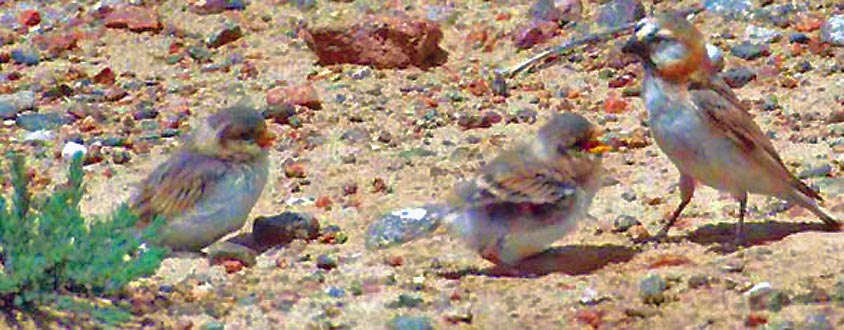 |
||
| It should be mentioned that all other global checklists place the Cinnamon Ibon Hypocryptadius cinnamomeus, of montane Mindanao, Philippines, in the Passeridae. Using molecular methods, Fjeldså et al. (2010) shocked the ornithology world by showing this bird of cloud forests had evolved at the base of the Passeridae clade. The was shocking as it had traditionally been considered to be an unusual white-eye among the Zosteropidae. The name of the paper was "The Cinnamon Ibon Hypocryptadius cinnamomeus is a forest canopy sparrow," and now "everyone" lists this unique species among the Old World Sparrows. However, Fjeldså et al. (2010) opined that the Ibon had diverged from the rest of the Passeridae about 31 million years ago. This is much older than many other bird lineages that are now considered worthy of Family level designation. Perhaps there is reason to wish for substantiation of the timing of divergence, but for now, consistent with the apparent age of divergence, I have elevated it at Family level as the Hypocryptadiidae. | ||
Photos: The Cape Sparrow Passer melanurus at Cape Town, South Africa, in March 2007. The male House Sparrow P. domesticus was photographed in Monterey, Calif., USA, where it is an introduced species. The large photo of Eurasian Tree Sparrow P. montanus is from Sulawesi, Indonesia, on 6 Oct 2011, and the nest-building male was in the Caka Valley, Qinghai, China, on 20 June 2004. The male Plain-backed Sparrow P. flaveolus was at Pak Thule, Thailand, on 22 Dec 2012. The Rock Petronia Petronia petronia was in the Caka Valley, Qinghai, China, on 20 June 2004. The female Pére David's Snowfinch Montifringilla davidiana was near Qinghai Lake, China, on 17 June 2004, and the male with fledglings Blanford's Snowfinch Montifringilla blanfordi were in the Caka Valley, Qinghai, China, the next day. All photos © Don Roberson; all rights reserved. Bibliographic note:
A fine introduction to the Passeridae, with some excellent photos, is in Summers-Smith (2009). Literature cited:
|
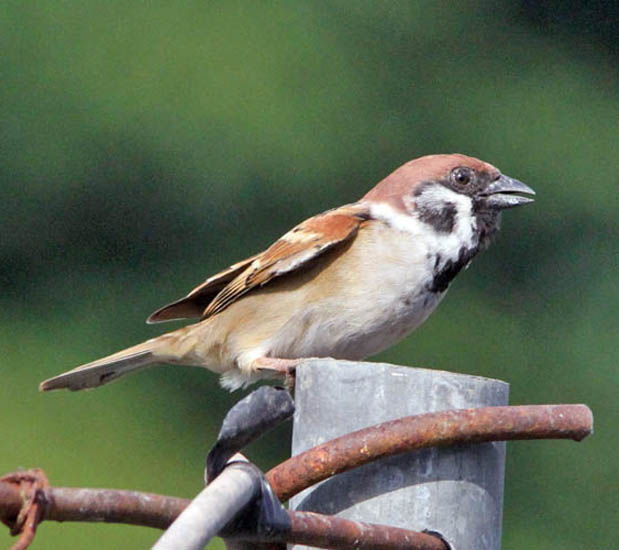 The other globally widespread member genus Passer is Eurasian Tree Sparrow
(left and below). This adaptable species occurs from sea-level (left, a
photo from Sulawesi, where it was introduced) to high elevations. The
nest-building bird below was at nearly 12,000' elevation (3600m in
Qinghai, China.
The other globally widespread member genus Passer is Eurasian Tree Sparrow
(left and below). This adaptable species occurs from sea-level (left, a
photo from Sulawesi, where it was introduced) to high elevations. The
nest-building bird below was at nearly 12,000' elevation (3600m in
Qinghai, China. 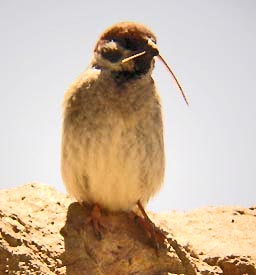
 There are many more localized sparrows in genus Passer, but most of them are commensals with humans to some extent (17 of 27 per Summers-Smith 2009). The Plain-backed Sparrow
of southeast Asia (right) is more rural than Eurasian Tree Sparrow, and
is localized in occurrence, but still prefers man-altered habitats such
as agricultural areas or the edges of villages.
There are many more localized sparrows in genus Passer, but most of them are commensals with humans to some extent (17 of 27 per Summers-Smith 2009). The Plain-backed Sparrow
of southeast Asia (right) is more rural than Eurasian Tree Sparrow, and
is localized in occurrence, but still prefers man-altered habitats such
as agricultural areas or the edges of villages. 